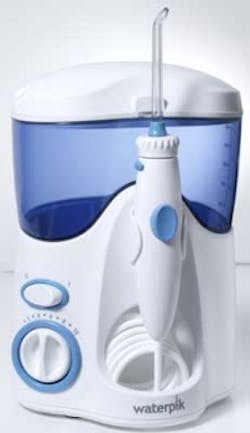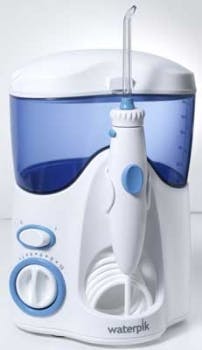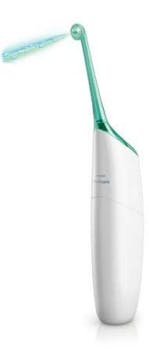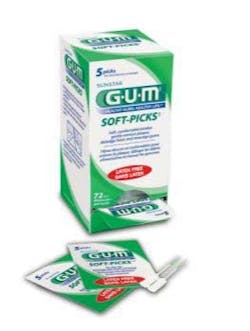Oral hygiene care during orthodontic therapy
By Maria Perno Goldie, RDH, MS
As with any treatment modality, there are risks and complications frequently encountered in orthodontic treatment. There are habits and techniques that can be utilized to minimize such risks and complications in the course of orthodontic treatment. Dental decay usually occurs on smooth surfaces and is a common complication in orthodontics, affecting 2% to 96% of all orthodontic patients.(1) Increased risk of dental decay during treatment is due to several factors, including: the carious lesions are difficult to locate; the resting pH is lowered; there is increased volume of dental plaque; and there is a rapid shift in bacterial flora.(2) This section will review the necessity of oral hygiene care during orthodontic treatment and preventive measures suggested to minimize complications during such treatment. The relationship between decay incidence and oral hygiene during orthodontic treatment has been studied. In one study instruction in toothbrushing was given, and topical application of sodium fluoride was used regularly throughout the experimental period.(3) The average period of treatment was 19 months. Monthly assessments of oral hygiene were performed through partial recordings utilizing the Plaque (PII) and Gingival Index (GI) systems. The results demonstrated a definite correlation between oral health and decay incidence. A more recent study showed the incidence of white spot lesions in patients treated with comprehensive orthodontics was significantly high, and the preventive therapy provided appeared to be ineffective.(4) The authors concluded that this prevalent problem is disturbing and merits considerable attention from both patients and providers that should result in greatly increased emphasis on effective caries and decay prevention.Another study looked at risk factors for the development of incipient decay during orthodontic treatment by retrospectively determining the incidence and severity of white spot lesions. This was done by examining pretreatment and post treatment digital photographs.(5) They found the development of incipient lesions during orthodontic treatment related to risks of young age (preadolescent) at the start of treatment, the number of poor hygiene citations during treatment, unfavorable clinical outcome score, white ethnic group, and inadequate oral hygiene at the initial pretreatment examination. The use of computer software to evaluate digital photos retrospectively is a valid method for assessing the incidence and severity of WSLs on the maxillary anterior incisors, canines, and premolars. Preventive measures to minimize damage include intensive oral hygiene instruction and monitoring, and dietary education. At each visit, oral hygiene and dietary education should be reinforced. Remineralizing agents can be prescribed for daily use to decrease the incidence of decay, such as 0.05% sodium fluoride rinse.(6) Where demineralization is already visible, various methods have been recommended including the use of fluoride toothpaste and adjunctive fluoride mouthwashes (0.05% sodium fluoride daily rinse or 0.2% sodium fluoride weekly rinse) to help remineralization of the affected area.Oral hygiene instruction is essential in all cases of orthodontic treatment, and the use of adjuncts such as power or electric toothbrushes, interproximal brushes, chlorhexidine mouthwashes, fluoride mouthwashes, and regular professional cleaning must be reinforced. However, patient motivation and dexterity are vital in the success of oral hygiene. Experience shows those who are unable to maintain a healthy oral environment in the absence of fixed orthodontics, will fail enormously with brackets and wires in place. In such patients, benefits may therefore significantly outweigh the risks of treatment.Most patients are able to prevent these problems with a combination of proper diet, optimal self care such as tooth brushing and interdental cleaning, and regular checkups. Brushing teeth immediately after eating, using the proper techniques for brushing with braces, and even rinsing vigorously with water is helpful to prevent decay. Excellent oral hygiene and plaque removal are critical, as is avoidance or minimizing consumption of sugar, carbonated beverages and energy drinks, and between meal snacks.
As with any treatment modality, there are risks and complications frequently encountered in orthodontic treatment. There are habits and techniques that can be utilized to minimize such risks and complications in the course of orthodontic treatment. Dental decay usually occurs on smooth surfaces and is a common complication in orthodontics, affecting 2% to 96% of all orthodontic patients.(1) Increased risk of dental decay during treatment is due to several factors, including: the carious lesions are difficult to locate; the resting pH is lowered; there is increased volume of dental plaque; and there is a rapid shift in bacterial flora.(2) This section will review the necessity of oral hygiene care during orthodontic treatment and preventive measures suggested to minimize complications during such treatment. The relationship between decay incidence and oral hygiene during orthodontic treatment has been studied. In one study instruction in toothbrushing was given, and topical application of sodium fluoride was used regularly throughout the experimental period.(3) The average period of treatment was 19 months. Monthly assessments of oral hygiene were performed through partial recordings utilizing the Plaque (PII) and Gingival Index (GI) systems. The results demonstrated a definite correlation between oral health and decay incidence. A more recent study showed the incidence of white spot lesions in patients treated with comprehensive orthodontics was significantly high, and the preventive therapy provided appeared to be ineffective.(4) The authors concluded that this prevalent problem is disturbing and merits considerable attention from both patients and providers that should result in greatly increased emphasis on effective caries and decay prevention.Another study looked at risk factors for the development of incipient decay during orthodontic treatment by retrospectively determining the incidence and severity of white spot lesions. This was done by examining pretreatment and post treatment digital photographs.(5) They found the development of incipient lesions during orthodontic treatment related to risks of young age (preadolescent) at the start of treatment, the number of poor hygiene citations during treatment, unfavorable clinical outcome score, white ethnic group, and inadequate oral hygiene at the initial pretreatment examination. The use of computer software to evaluate digital photos retrospectively is a valid method for assessing the incidence and severity of WSLs on the maxillary anterior incisors, canines, and premolars. Preventive measures to minimize damage include intensive oral hygiene instruction and monitoring, and dietary education. At each visit, oral hygiene and dietary education should be reinforced. Remineralizing agents can be prescribed for daily use to decrease the incidence of decay, such as 0.05% sodium fluoride rinse.(6) Where demineralization is already visible, various methods have been recommended including the use of fluoride toothpaste and adjunctive fluoride mouthwashes (0.05% sodium fluoride daily rinse or 0.2% sodium fluoride weekly rinse) to help remineralization of the affected area.Oral hygiene instruction is essential in all cases of orthodontic treatment, and the use of adjuncts such as power or electric toothbrushes, interproximal brushes, chlorhexidine mouthwashes, fluoride mouthwashes, and regular professional cleaning must be reinforced. However, patient motivation and dexterity are vital in the success of oral hygiene. Experience shows those who are unable to maintain a healthy oral environment in the absence of fixed orthodontics, will fail enormously with brackets and wires in place. In such patients, benefits may therefore significantly outweigh the risks of treatment.Most patients are able to prevent these problems with a combination of proper diet, optimal self care such as tooth brushing and interdental cleaning, and regular checkups. Brushing teeth immediately after eating, using the proper techniques for brushing with braces, and even rinsing vigorously with water is helpful to prevent decay. Excellent oral hygiene and plaque removal are critical, as is avoidance or minimizing consumption of sugar, carbonated beverages and energy drinks, and between meal snacks.
Oral hygiene devices for making the process of cleaning orthodontics appliances are available. Rubber-tipped and end-tuft or single-tuft brushes, oral irrigators like the Waterpik, and antibacterial and fluoride rinses are a few. In one study, the use of a manual toothbrush and the Waterpik Water Flosser with the Orthodontic Tip was compared to manual toothbrushing and flossing with a floss threader on bleeding and plaque biofilm reductions in adolescents with fixed orthodontic appliances. A control group consisted of brushing only.(7) The results showed that a dental water jet with a specialized orthodontic jet tip was effective for adolescents in fixed orthodontic appliances and it demonstrated beneficial results for the reduction of plaque and bleeding.(8)
An in vivo study compared the plaque removal and gingivitis reduction ability for the Sonicare FlexCare (ProResults brush head) and Oral-B P-40 manual toothbrush in orthodontic population.(9) The Sonicare FlexCare demonstrated superior plaque reduction over a manual toothbrush. The Sonicare Flexcare or Sonicare for Kids toothbrushes or the new AirFloss are options for patients.(10)
Manual brushes are available as well. The Oral-B Orthodontic Brush uses V-shaped bristles to remove plaque from braces and teeth. It can be used as a braces toothbrush or as a brush to clean wires and brackets associated with retainers, headgear and other types of orthodontic work. The Oral-B Ortho is recommended for both adults and children with braces, since it is designed to clean around the orthodontic brackets. Regarding the power brush, the Oral-B PowerTip brushhead can be used in conjunction with one of these brushheads to clean around bridges, crowns, or implants. For children, the Oral-B Kids' Power brushhead has extra-soft bristles and a special longer row to clean chewing surfaces.(11,12,13,14) Cleaning removable appliance like aligners and retainers is important as well. Specialty items like FlossFish(15) and the Platypus Orthodontic Flosser(16) are available. Specialty websites are available that specialize in new and innovative high-quality orthodontic products. An example is DentaKit for Invisible Braces & Retainers, for people with "Invisalign-type" aligners.(17) The Sunstar G•U•M Proxabrush Interdental System is available for cleaning between archwire and teeth and for larger spaces between teeth.(18) There is also a G•U•M Orthodontic toothbrush, with a “V” trim, and a soft brush that facilitates cleaning around orthodontic appliances such as brackets, arch wires, buttons and ligatures. It is also available as a travel brush with antibacterial protected bristles. Bristles have a patented chlorhexidine antibacterial coating for bristle protection.
Other interdental cleaners may be useful during orthodontic treatment. In one study, dental floss, the recognized “gold standard” for gingivitis reduction, was matched in performance by flossers and an interdental cleaner with small elastomeric fingers, and surpassed by an interdental brush.(19) All products performed comparably for plaque reduction and removal. Glide dental floss, Butler flossers, GUM Go-Betweens cleaners, and GUM Soft-Picks cleaners were studied. TePe, a Swedish company, has many suitable products and a brochure: “Caring for your braces is a guide to suitable products and home care for orthodontic patients.”(20) TePe Interspace is an angled brush with a pointed tuft, is ideal for cleaning critical areas close to the brackets and under the wires.(21) Two different angles can be chosen for optimal access. The TePe Interdental Brush is available in several sizes and in two textures, soft and extra soft. The extra soft brushes have longer filaments, which can be suitable for orthodontic patients.While this is not an exhaustive list, it is a beginning to assist us in helping those undergoing orthodontic treatments to achieve optimal self care. Motivational interviewing is a technique that may help promote compliance with professionals’ recommendations.References
1. Chang HS, Walsh LJ, Freer TJ. Enamel demineralization during orthodontic treatment. Aetiology and prevention. Aust Dent J 1997; 42:322-7.2. Yun-Wah Lau P and Wing-Kit Wong R. Risks and complications in orthodontic treatment. Hong Kong Dental Journal 2006; 3:15-22.3. Zaghrisson BU and Zaghrisson S. Caries incidence and oral hygiene during orthodontic treatment. European Journal of Oral Sciences Volume 79, Issue 4, pages 394–401, August 1971, Article first published online: 1 OCT 2007.4. Richter AE, Arruda AO, Peters MC, and Sohn W. Incidence of caries lesions among patients treated with comprehensive orthodontics. American Journal of Orthodontics & Dentofacial Orthopedics - May 2011 (Vol. 139, Issue 5, Pages 657-664, DOI: 10.1016/j.ajodo.2009.06.037. 5. Chapman JA, Roberts WE, Eckert GJ, Kula KS, and González-Cabezas C. Risk factors for incidence and severity of white spot lesions during treatment with fixed orthodontic appliances. American Journal of Orthodontics & Dentofacial Orthopedics - August 2010 (Vol. 138, Issue 2, Pages 188-194, DOI: 10.1016/j.ajodo.2008.10.019. 6. Geiger AM, Gorelick L, Gwinnett AJ, and Benson BJ. Reducing white spot lesions in orthodontic populations with fluoride rinsing. Am J Orthod Dentofacial Orthop 1992; 101:403-7.7. professional.waterpik.com/pdfs/clinical-research/Sharma_orthodontics_021010_v5.pdf.8. Sharma NC, Lyle DM, Qaqish JG, Galustians J, and Schuller R. Effect of a dental water jet with orthodontic tip on plaque and bleeding in adolescent patients with fixed orthodontic appliances. American Journal of Orthodontics & Dentofacial Orthopedics, Volume 133, Issue 4 , Pages 565-571, April 2008.9. Putt M, Milleman J, Delaurenti M, Jenkins W, Wei J, Strate J. Comparison of plaque removal in orthodontic subjects by Sonicare FlexCare and a manual brush. J Dent Res 87 (spec Iss B): 2044, 2008. www.sonicare.com/professional/dp/pdf/Plaque_FC_2008_DeLaurenti.pdf. 10. www.sonicare.com/professional/dp/DP/Default.aspx.11. www.oralbprofessional.com/us/products/power/powheads.asp.12. www.oralb.com/topics/orthodontics-braces.aspx. 13. www.oralb.com/products/electric-toothbrush/.14. www.dentalcare.com/en-US/products/power.jspx.15. www.flossfish.com/.16. www.platypusco.com.17. www.dentakit.com/. 18. www.gumbrand.com/home-professional.aspx. 19. Yost KG, Sunstar Americas, Inc., Mallatt ME, Indiana State Department of Health, Liebman J, and Hill Top Research. Interproximal Gingivitis and Plaque Reduction by Four Interdental Products. J Clin Dent 17:79–83, 2006. www.gumbrand.com/n/pdffiles/content/SoftPicks%20Clinical.pdf. 20. www2.tepe.com/fileadmin/uploads/Printed_Material_eng/patientfolder_ortho_UK_lowres.pdf. 21. www2.tepe.com/user-tips/orthodontics/.To read previous articles in RDH eVillage FOCUS from 2011 written by Maria Perno Goldie, go to articles.
1. Chang HS, Walsh LJ, Freer TJ. Enamel demineralization during orthodontic treatment. Aetiology and prevention. Aust Dent J 1997; 42:322-7.2. Yun-Wah Lau P and Wing-Kit Wong R. Risks and complications in orthodontic treatment. Hong Kong Dental Journal 2006; 3:15-22.3. Zaghrisson BU and Zaghrisson S. Caries incidence and oral hygiene during orthodontic treatment. European Journal of Oral Sciences Volume 79, Issue 4, pages 394–401, August 1971, Article first published online: 1 OCT 2007.4. Richter AE, Arruda AO, Peters MC, and Sohn W. Incidence of caries lesions among patients treated with comprehensive orthodontics. American Journal of Orthodontics & Dentofacial Orthopedics - May 2011 (Vol. 139, Issue 5, Pages 657-664, DOI: 10.1016/j.ajodo.2009.06.037. 5. Chapman JA, Roberts WE, Eckert GJ, Kula KS, and González-Cabezas C. Risk factors for incidence and severity of white spot lesions during treatment with fixed orthodontic appliances. American Journal of Orthodontics & Dentofacial Orthopedics - August 2010 (Vol. 138, Issue 2, Pages 188-194, DOI: 10.1016/j.ajodo.2008.10.019. 6. Geiger AM, Gorelick L, Gwinnett AJ, and Benson BJ. Reducing white spot lesions in orthodontic populations with fluoride rinsing. Am J Orthod Dentofacial Orthop 1992; 101:403-7.7. professional.waterpik.com/pdfs/clinical-research/Sharma_orthodontics_021010_v5.pdf.8. Sharma NC, Lyle DM, Qaqish JG, Galustians J, and Schuller R. Effect of a dental water jet with orthodontic tip on plaque and bleeding in adolescent patients with fixed orthodontic appliances. American Journal of Orthodontics & Dentofacial Orthopedics, Volume 133, Issue 4 , Pages 565-571, April 2008.9. Putt M, Milleman J, Delaurenti M, Jenkins W, Wei J, Strate J. Comparison of plaque removal in orthodontic subjects by Sonicare FlexCare and a manual brush. J Dent Res 87 (spec Iss B): 2044, 2008. www.sonicare.com/professional/dp/pdf/Plaque_FC_2008_DeLaurenti.pdf. 10. www.sonicare.com/professional/dp/DP/Default.aspx.11. www.oralbprofessional.com/us/products/power/powheads.asp.12. www.oralb.com/topics/orthodontics-braces.aspx. 13. www.oralb.com/products/electric-toothbrush/.14. www.dentalcare.com/en-US/products/power.jspx.15. www.flossfish.com/.16. www.platypusco.com.17. www.dentakit.com/. 18. www.gumbrand.com/home-professional.aspx. 19. Yost KG, Sunstar Americas, Inc., Mallatt ME, Indiana State Department of Health, Liebman J, and Hill Top Research. Interproximal Gingivitis and Plaque Reduction by Four Interdental Products. J Clin Dent 17:79–83, 2006. www.gumbrand.com/n/pdffiles/content/SoftPicks%20Clinical.pdf. 20. www2.tepe.com/fileadmin/uploads/Printed_Material_eng/patientfolder_ortho_UK_lowres.pdf. 21. www2.tepe.com/user-tips/orthodontics/.To read previous articles in RDH eVillage FOCUS from 2011 written by Maria Perno Goldie, go to articles.
Maria Perno Goldie, RDH, MS





